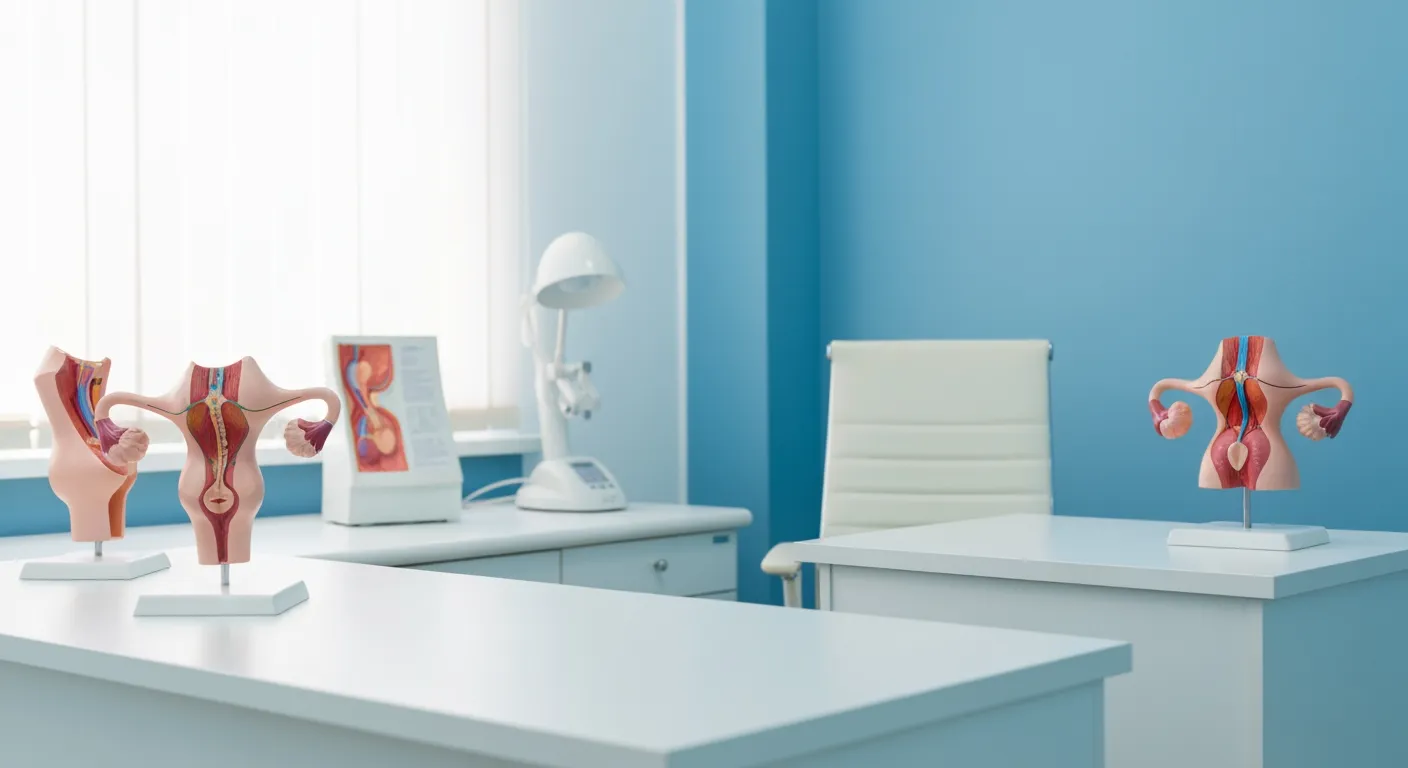Empowering Women's Health Through Personalized Menopause Care

Understanding Modern Approaches to Ovarian Cyst Treatment
Ovarian cysts are common gynecologic conditions that often require medical intervention when persistent, large, or symptomatic. Traditional open surgery has given way to minimally invasive techniques that enhance patient recovery while preserving ovarian function and fertility. This article explores the latest innovations, surgical strategies, and outcomes associated with minimally invasive treatments for ovarian cysts, offering readers a comprehensive overview of current and emerging options.
Minimally Invasive Treatment Options for Ovarian Cysts
What are the minimally invasive treatment options available for ovarian cysts?
Minimally invasive approaches to treating ovarian cysts have become a standard due to their effectiveness and lower risk profile. The most common technique is laparoscopic ovarian cystectomy, which involves small incisions through which a laparoscope and specialized instruments are inserted. This allows gynecologists to carefully visualize and remove the cysts without large abdominal cuts.
Laparoscopy offers notable benefits such as less postoperative pain, quicker recovery times, and minimal scarring. It is often preferred over traditional open surgery, especially for benign cysts. In addition, some cases may involve ovarian cyst aspiration, where fluid is drained from the cyst under ultrasound guidance. This is a less invasive procedure mainly used for diagnostic purposes or symptom relief but doesn't always prevent cyst recurrence.
For very large cysts or when there is a suspicion of malignancy, surgeons might opt for laparoscopic-assisted techniques or, in certain situations, open surgery. These options are tailored based on cyst size, morphology, and the patient's overall health.
Beyond cystectomy, emerging minimally invasive technologies include radiofrequency ablation techniques such as Sonata® and Acessa®, which shrink fibroids and treat cystic structures with less tissue damage. These options show promise in reducing recovery time and preserving ovarian function.
In summary, the main minimally invasive methods include:
| Treatment Approach | Description | Advantages |
|---|---|---|
| Laparoscopic ovarian cystectomy | Removal of cysts through small incisions with a camera | Less pain, quick recovery, minimal scarring |
| Cyst aspiration | Draining cyst fluids guided by ultrasound | Less invasive but less definitive |
| Radiofrequency ablation | Using energy to shrink cysts or fibroids | Minimally invasive, preserves tissue |
Choosing the best method depends on the cyst’s attributes, the patient's health, and the surgeon's judgment. Overall, minimally invasive options improve outcomes and reduce recovery times, making them the preferred choice for appropriate cases.
Surgical Techniques in Minimally Invasive Ovarian Cyst Management

What surgical techniques are used in minimally invasive ovarian cyst management?
Minimally invasive management of ovarian cysts primarily involves laparoscopic cystectomy, a technique that uses small incisions, usually less than 1 cm, through which a laparoscope and surgical instruments are inserted. The laparoscope provides real-time visualization of the ovaries and surrounding structures, allowing for precise dissection.
During the procedure, the surgeon carefully isolates the cyst, often aspirating its contents with a needle to reduce its size if necessary. The cyst is then meticulously dissected from the ovarian tissue, aiming to preserve as much healthy ovary as possible.
Specialized tools such as harmonic scalpels or bipolar forceps are used to control bleeding. Hemostasis is crucial not only for operative success but also to preserve ovarian function.
In cases of large or complex cysts, initial cyst drainage is performed to facilitate easier removal and minimize the risk of spillage. To prevent spilling cyst contents into the abdominal cavity—which could cause complications or spread potentially malignant cells—surgeons often deploy specimen retrieval bags, such as Endocatch bags. These allow for safe extraction of the cyst in a contained environment.
Beyond cystectomy, alternative minimally invasive techniques include laser ablation, particularly using CO2 fiber lasers, which can destroy the cyst lining while sparing surrounding tissue. This approach aims to reduce the impact on ovarian reserve and may result in better fertility outcomes.
Overall, these modern laparoscopic techniques offer significant advantages over traditional open surgery, including less pain, shorter hospital stays, quicker recovery, and better preservation of ovarian function. They are especially beneficial for women wishing to maintain fertility, as they minimize damage to ovarian tissue and reduce the risks associated with cyst spillage or extensive tissue removal.
Incorporation of Laser Ablation Technology
Laser ablation, especially with CO2 fiber lasers, is gaining recognition as a less aggressive alternative to cystectomy. This technique selectively targets the cyst lining, vaporizing it with minimal thermal spread. Its precision helps preserve healthy ovarian tissue, thereby maintaining ovarian reserve and improving fertility prospects. Early research indicates that laser ablation results in less impact on ovarian reserve markers like Anti-Müllerian Hormone (AMH), which tend to decline after cystectomy.
Specimen Handling to Prevent Spillage
Handling specimens carefully is critical. The use of retrieval bags ensures that cyst contents are contained during removal, significantly reducing the risk of spillage. Proper specimen handling not only minimizes the risk of chemical peritonitis or adhesive disease but also prevents potential dissemination of malignant cells if a cyst is unexpectedly cancerous.
| Technique | Description | Benefits | Additional Info |
|---|---|---|---|
| Laparoscopic cystectomy | Small incisions, dissection, preservation of ovarian tissue | Less pain, quicker recovery, fertility preservation | Uses specialized devices for dissection |
| Laser ablation (CO2) | Vaporizes cyst lining selectively with laser | Preserves ovarian reserve, minimally thermal spread | Suitable for certain cyst types |
| Specimen retrieval | Use of endoscopic bags during removal | Prevents spillage, reduces risk of complications | Critical for safety in large or suspicious cysts |
The combination of these techniques exemplifies the advancement in minimally invasive gynecologic surgery, prioritizing patient safety, ovarian preservation, and fertility outcomes.
Benefits of Minimally Invasive Procedures: Recovery and Fertility Preservation

What are the benefits of minimally invasive procedures for ovarian cysts in terms of recovery and fertility?
Minimally invasive procedures, such as laparoscopic ovarian cystectomy, provide notable advantages for patients undergoing ovarian cyst removal. These techniques involve small incisions, which lead to less postoperative pain and quicker recovery periods. Typically, women can return to their normal activities within one to three weeks, a significant improvement over open surgeries, which may require 6-8 weeks of recovery.
One of the primary concerns with ovarian cystectomy is its impact on ovarian reserve— the remaining functional eggs and hormonal production capacity. Studies indicate that laparoscopic approaches are better at preserving ovarian tissue, which helps maintain ovarian reserve markers like Anti-Müllerian Hormone (AMH). This preservation is crucial for women who wish to conceive, as it can translate into higher spontaneous pregnancy rates.
Compared to open surgery, minimally invasive procedures are associated with fewer risks such as infections, adhesions, and injury to surrounding structures. Less trauma to the ovaries and surrounding tissues supports hormonal health and overall reproductive function.
In addition, alternative techniques like CO2 laser ablation are being explored for their potential to preserve ovarian tissue even further. Early research suggests these methods cause less thermal damage and may better sustain ovarian blood flow, which is vital for long-term fertility.
Overall, minimally invasive ovarian cyst removal offers a safer, less painful, and more fertility-friendly option that aligns with modern gynecologic care goals. It minimizes hospital stay, reduces complications, and helps maintain reproductive potential, making it an excellent choice for women wishing to preserve their fertility while effectively treating ovarian cysts.
Innovations and Advancements in Gynecologic Surgery for Ovarian Cysts

Recent developments in gynecologic surgery have transformed how ovarian cysts are treated, emphasizing minimally invasive techniques that offer reduced risks and quicker recovery. Robotic-assisted surgery stands out as a recent innovation, providing surgeons with enhanced precision, stability, and control during complex procedures. This approach is especially beneficial for large or difficult cysts, where meticulous removal is critical.
Hysteroscopic surgery and vNOTES (vaginal natural orifice transluminal endoscopic surgery) are emerging as less invasive alternatives. Hysteroscopic procedures allow treatment through the vaginal canal without abdominal incisions, while vNOTES eliminates external scars altogether, enabling faster healing and minimal disruption.
In addition to surgical approaches, laser and radiofrequency ablation techniques have gained prominence. Laser technologies such as CO2 laser vaporization provide highly targeted treatment of ovarian cysts with minimal thermal spread and tissue damage. This helps preserve ovarian tissue and function, which is crucial for women concerned with fertility.
Radiofrequency ablation techniques like Sonata® and Acessa® are also used to shrink fibroids and cysts effectively. These methods aim to reduce cyst size and symptoms with fewer complications, allowing most women to resume normal activities within days.
Enhanced imaging and ultrasound-guided interventions play a significant role in these advancements. These technologies enable real-time visualization during procedures, ensuring precise targeting of cysts while sparing healthy ovarian tissue. Such innovations improve success rates and further reduce the impact on ovarian reserve.
| Innovation Type | Description | Benefits | Typical Use Cases |
|---|---|---|---|
| Robotic-assisted surgery | Advanced robotic systems for precise manipulation | Enhanced accuracy, complex case handling | Large or complicated ovarian cysts |
| Hysteroscopic and vNOTES techniques | Minimally invasive approaches via natural orifices | No visible scars, quick recovery | Cyst removal in suitable cases |
| Laser ablation (CO2 laser) | Targeted vaporization of cyst tissue | Preserves ovarian tissue, less thermal spread | Endometriomas, benign cysts |
| Radiofrequency ablation | Uses radiofrequency energy to reduce cyst size | Minimizes tissue damage, rapid recovery | Fibroids, cysts |
| Advanced imaging and ultrasound-guided | Real-time imaging to facilitate precise intervention | Increased safety, accuracy | All minimally invasive procedures |
Overall, these technological advances allow for more personalized, effective, and less invasive treatment options for women with ovarian cysts. They represent significant steps forward in preserving ovarian function and improving patient outcomes, reducing hospital stays, and minimizing postoperative complications.
Risks and Considerations in Minimally Invasive Ovarian Cyst Treatments

What are the risks and considerations associated with minimally invasive treatments for ovarian cysts?
Minimally invasive procedures, such as laparoscopic ovarian cystectomy, are favored for their numerous benefits, including quicker recovery and lower complication rates. However, they still involve certain risks. Potential surgical complications include bleeding, infection, and injury to nearby structures such as blood vessels, bowel, or bladder. Adhesion formation is a concern that can affect future fertility. There is also the possibility of cyst recurrence, which may necessitate additional treatment.
Despite these risks, the procedures generally provide better outcomes for ovarian preservation and fertility compared to open surgery. Important considerations involve the size and nature of the cyst — larger or suspected potentially malignant cysts may require different approaches. Patient age, reproductive goals, and ovarian reserve markers should also influence treatment planning.
Preoperative assessments, including imaging and possibly tumor markers, are crucial for selecting the most appropriate treatment. Surgeons trained in advanced laparoscopic techniques can minimize intraoperative risks.
The overall approach emphasizes careful patient selection and skilled surgical execution to ensure safety and optimize fertility outcomes. When performed properly, minimally invasive procedures are a safe, effective alternative with fewer postoperative complications and faster return to daily activities.
Specific Procedures: Ovarian Cystectomy and Laser Ablation
What specific minimally invasive procedures, such as ovarian cystectomy and laser ablation, are used for the treatment of ovarian cysts?
Minimally invasive options for ovarian cyst treatment primarily include laparoscopic ovarian cystectomy and laser ablation techniques, such as CO2 laser vaporization.
Laparoscopic ovarian cystectomy involves small incisions through which a camera and specialized surgical tools are inserted. The surgeon carefully removes the cyst, often preserving as much healthy ovarian tissue as possible. This approach minimizes patient discomfort, reduces recovery time, and is effective for large or complex cysts.
In contrast, laser ablation methods, like CO2 laser vaporization, deliver a precise, focused laser beam to vaporize cystic tissue directly. This technique is particularly advantageous in treating endometriomas, as it spares ovarian tissue by vaporizing rather than removing the cyst, potentially better preserving ovarian function.
CO2 laser vaporization technique
The CO2 laser method utilizes a highly focused laser that minimizes thermal spread, allowing targeted vaporization of cyst tissue. It offers a highly selective approach, reducing damage to adjacent ovarian tissue.
This technique is associated with less impact on ovarian reserve markers and has shown promising early results in preserving ovarian microvasculature and function.
Comparative fertility outcomes
Research suggests that laser ablation may have a more favorable impact on ovarian reserve compared to traditional cystectomy, especially in cases involving bilateral cysts.
Preliminary evidence indicates that women undergoing CO2 laser ablation experience less decline in anti-Müllerian hormone (AMH) levels, a marker of ovarian reserve, and maintain better fertility outcomes.
In contrast, cystectomy, while effective at removing cysts, has been associated with a reduction in ovarian reserve and lower post-surgical pregnancy rates.
Indications for each procedure
Both procedures are indicated when ovarian cysts cause pain, interfere with fertility, or have suspicious features suggestive of malignancy.
Laser ablation is often preferred for endometriomas because it may better preserve ovarian tissue.
Cystectomy remains standard for benign, large, or complex cysts where complete removal is necessary.
The choice between procedures depends on cyst size, type, location, patient’s reproductive goals, and surgeon expertise.
| Procedure | Main Focus | Benefits | Suitable Cases |
|---|---|---|---|
| Laparoscopic cystectomy | Removal of cyst | Less invasive, quick recovery | Large, complex, or suspicious cysts |
| CO2 laser vaporization | Tissue vaporization | Preserves ovarian tissue, less impact on reserve | Endometriomas, bilateral cysts |
This personalized approach aims to optimize fertility outcomes while minimizing damage to ovarian function.
Effectiveness of Minimally Invasive Treatments for Large or Complex Ovarian Cysts

Minimally invasive approaches, such as laparoscopic assisted extracorporeal ovarian cystectomy, have demonstrated significant effectiveness in treating large or complex ovarian cysts. This technique involves initial diagnostic laparoscopy to assess the cyst, followed by a small mini-laparotomy for cyst removal outside the abdominal cavity, which reduces intra-abdominal trauma.
The procedure typically includes applying adhesive barriers to prevent spillage, aspirating the cyst fluid with a needle and blunt suction, and then carefully extracting the ovary and cyst for extracorporeal cystectomy. This approach minimizes the risks associated with intraperitoneal spillage — a concern particularly with potential malignant or benign cysts — and offers benefits similar to other minimally invasive surgeries, such as reduced postoperative pain and quicker recovery.
Research indicates that even very large cysts, over 17 or 20 centimeters, can be safely managed with these techniques. Proper preoperative assessment, including imaging and tumor markers, helps distinguish benign from malignant cysts, ensuring appropriate method selection.
Studies comparing large versus smaller cysts show similar operation times, complication rates, and recovery periods, confirming that size alone does not contraindicate minimally invasive procedures. Enhancements like staged decompression and careful handling further improve safety and outcomes.
As ongoing research refines these methods, surgeons strive to lower recurrence rates, preserve ovarian function, and expand indications for minimally invasive management. These advances make the treatment of large or complex ovarian cysts increasingly feasible and effective, providing patients with safer options and faster recoveries.
| Technique | Size Limitations | Benefits | Additional Details |
|---|---|---|---|
| Laparoscopic assisted extracorporeal cystectomy | Up to 20+ cm | Reduced spillage, faster recovery | Combines laparoscopy with extracorporeal removal, ideal for large cysts |
| Intracapsular fluid aspiration | Any size, with caution | Decreases cyst volume, facilitates removal | Requires careful technique to avoid leakage |
| Robotic-assisted surgery | Large cysts, complex cases | Enhanced precision, preservation of tissue | Incorporates advanced visualization tools |
Overall, minimally invasive treatments provide a promising, safe, and effective option for managing large ovarian cysts, supported by ongoing research and technological innovations.
Embracing Minimally Invasive Innovations for Optimal Ovarian Cyst Care
Minimally invasive treatments for ovarian cysts represent a transformative advancement in gynecologic surgery, prioritizing patient recovery, ovarian preservation, and fertility outcomes. Continued innovation in surgical techniques—including laparoscopic cystectomy, laser ablation, robotic-assisted procedures, and novel approaches like vNOTES—enhances the safety and effectiveness of interventions, even for large or complex cysts. With appropriate patient selection, skilled surgical expertise, and ongoing research, minimally invasive options offer a personalized, less traumatic alternative to traditional open surgery. As these approaches evolve, they promise improved quality of life and reproductive health for women worldwide.
References
- A Minimally Invasive Approach to a Large Ovarian Cyst
- Minimally invasive surgery for ovarian endometriosis as a ...
- Minimally invasive gynecologic surgery - Overview
- Ovarian Cystectomy: Purpose, Procedure, Risks & Recovery
- The Rise of Laparoscopic Surgery
- Advanced Minimally Invasive GYN Surgery Puts You at the ...
- The Latest Advances in Minimally Invasive Gynecologic ...





.png)